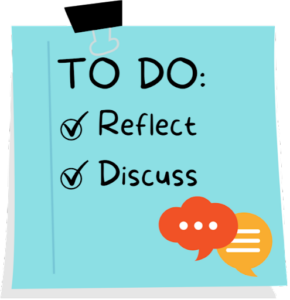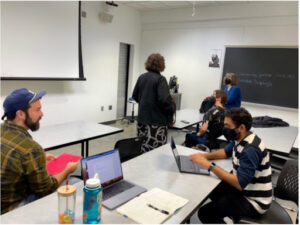By Elise Daugherty

It is easy to get caught up in the academic hamster wheel, constantly keeping track of due dates, studying, readings, networking, and applications. In what is often an intense and fast-paced environment, it can be difficult to actually take stock of what you have learned, reflect on where you are, and redefine where you want to go. In our sixth week of class, we were guided by the theme of “Catch up, Check in, Reflect,” and our time together was spent doing just that. Through various reflective questions and discussions, we were able to better position ourselves and our understanding of curatorial work within the context of our ongoing collaboration between our Curatorial Practices class, the Museum Education course, and the Museum of Broken Relationships (MBR).
Dr. Holzman kicked things off by asking each of us to think about what was going well with the class, as well as what was confusing, and for us to consider where we (either individually or with groups) stood with our MBR exhibit elements. At the beginning of any class, my brain is usually still buzzing with five or so other ideas, things on my to-do list, or conversations, so, I have found these start-of-class reflection questions especially helpful for refocusing and recalling what concepts we have discussed in previous classes. Additional reflections asked us to consider our actions and our learning practices, questioning what from the class we might continue to do and what we will seek to do differently in the future.
These thoughts initiated discussion amongst the class about the logistical process of donating objects for the exhibit, as well as the concerns students had with explaining to potential donors that, though their object was valued, there was no guarantee that it would be physically on display in the gallery. If we want to build trust and demonstrate respect and value for these individuals and their objects after courting them for donations, providing some sort of pay-off may be important – be it in the form of a digital exhibit accompanying the physical one, or a catalogue of some sort to allow people’s stories and donations to be shared even when they are not on display.
The largest part of our conversation involved reflecting on the various partnerships present in this project. Perhaps the most significant partnership is with the Museum of Broken Relationships itself. This relationship has been years in the making, beginning with the personal network of one Museum Studies professor, growing into a pilot partnership with the Museum Education class in the fall of 2021, and culminating in this large exhibit project. Logistically, partnering with a museum located in another country presents challenges including navigating time differences and potentially different cultural expectations; but the opportunity to participate in a project that connects people around the world through stories and memories of a shared feeling is an incredible incentive to work through these challenges.
Another big partnership is with community partners who may not only provide content and object donations but also have the potential to host satellite displays (mini MBR exhibits). Community partners are integral to involving the community, including a diverse range of voices, and ensuring that the project has meaning for those outside of the University, but the process of that partnership can come with some challenges. Working with others requires both time and flexibility. Time is finite, and the more partners you add, the less time can be spent on each one. As we have seen in numerous examples, time and trust are often essential elements to establishing a functional working relationship (Dale-Hallet 2018; Simon 2010). Flexibility is often just as essential as time. Partnerships that seem set may be confronted with scheduling conflicts, health concerns, or any number of other obstacles, and it may be necessary to pivot or find new ways to partner together. Other partners discussed included the Indianapolis community outside of the community partners and the cross-campus partnerships between the Herron Galleries where the main exhibit will exist, and the two classes focused on helping it come to life.

Students sit in a classroom talking in small groups
As we considered the scope of the project and the questions we have around it, Dr. Holzman prompted us to revisit the concept of relational curating, as defined by Janet Marstine and Oscar Ho Hing Kay (2021, 2), which
“signif[ies] the relationships or ‘connectedness’ between objects and people, between institutions and people and among people, as facilitated by curators, to address both art world exclusions and inequalities and wider social and political concerns […and…] assumes responsibility for generating the productive conflict necessary for working relationally […] in a domain which has long claimed privilege and authority. Curating as a relational practice can be understood on an abstract level as a gesture of reconciliation.”
Our work in international, community, and cross-campus collaboration must be done with care as we consider how each of these partners is connected to the work, the objects, and the outcome of their involvement as well as the exhibit itself.
Elise Daugherty is a second-year graduate student in the IUPUI Museum Studies Program.
References:
Dale-Hallet, Liza. 2018. “Making meaning from ashes—the development of the Victorian Bushfires Collection.” National Council on Public History, May 2, 2018. https://ncph.org/history-at-work/the-development-of-the-victorian-bushfires-collection/
Marstine, J., & Ho Hing Kay, O. 2021. Curating Art. London: Routledge. https://doi.org/10.4324/9781315686943
Simon, Nina. 2010. “The Participatory Museum.” Santa Cruz, CA: Museum 2.0. https://www.participatorymuseum.org/

